The ASUS ROG Strix G15 (G513QY) Review: Embracing AMD's Advantage
by Brett Howse on May 31, 2021 11:00 PM ESTSystem Performance
The ASUS ROG Strix G513QY features the AMD Ryzen 9 5900HX processor, which is near the top of the Ryzen 5000 range. With eight cores, sixteen threads, and a 4.6 GHz peak frequency, this Zen 3 powered processor offers a rated 45-Watt TDP, compared to the 35-Watt in the 5900HS. It is also overclockable, if you want to tweak performance a bit more. For a full deep-dive into the latest Ryzen 5000 series, check out Ian’s article where he tested the 5900HS in-depth.
Compared to the outgoing Ryzen 4000 series “Renoir”, the Ryzen 5000 series “Cezanne” moves from Zen 2 to Zen 3 cores, and is still built on TSMC’s 7 nm process. Instructions-per-clock is up, and thanks to the process, the per-core efficiency is quite high. AMD chose to stick with the Vega 8 graphics, even on the 45-Watt chips, and while not ideal on the 15-Watt U-Series chips, the GPU is mostly irrelevant in this class, as most 45-Watt CPUs tend to be paired with dedicated graphics. That is the case here, with the AMD Radeon RX 6800M.
Thanks to the coupling of the AMD CPU and GPU, the ASUS Strix G513QY gets to take advantage of the shared power and AMD SmartShift. When the GPU is not active, the CPU can use up to 90 Watts of power, or up to 54 Watts sustained when the GPU is active. The GPU has a rated sustained power limit of 145-Watts, but can be increased up to 15% by leveraging some of the CPU’s power limit if it is not needed.
Memory on the unit is dual-channel DDR4-3200, with 16 GB in the review unit, but up to 32 GB available from ASUS. As this is a gaming laptop, the DDR4 will be in removable SODIMMs, allowing owners to upgrade their memory if they want.
To see how the system performs, it was run through our laptop suite. To compare the ASUS ROG Strix G513QY to any other system we have tested, please use our online bench tool.
PCMark 10
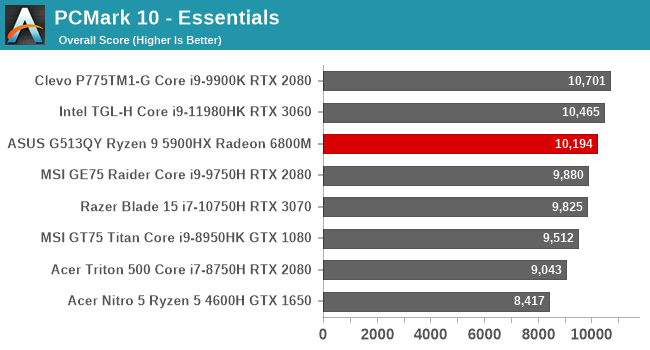
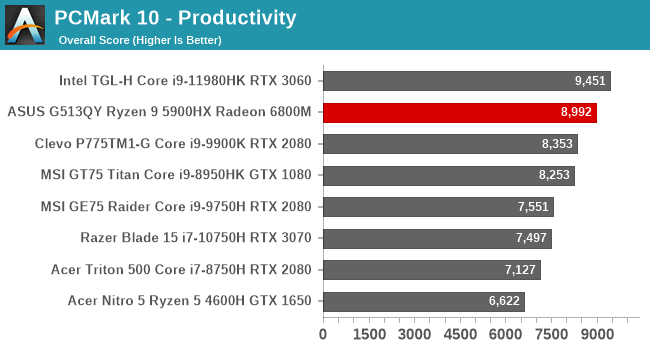
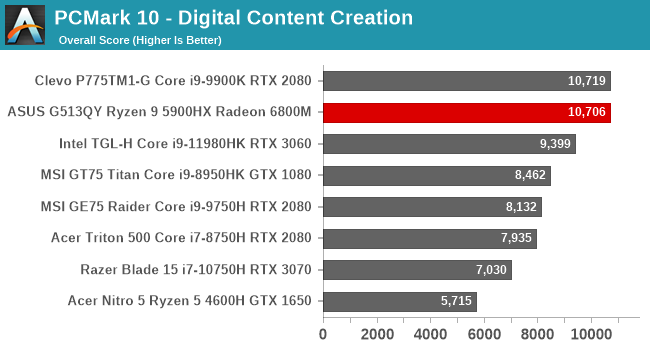
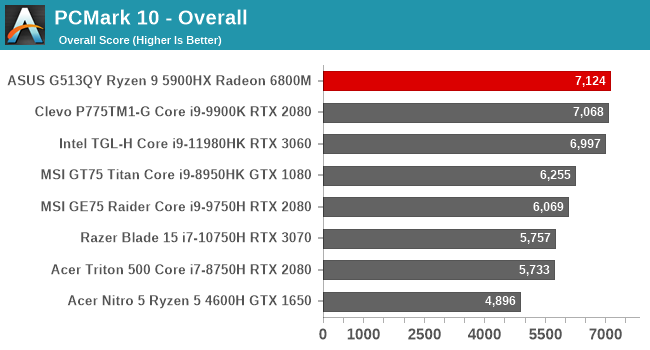
UL’s PCMark suite is a comprehensive benchmark tool which stresses all aspects of a system. In the overall suite, there are three sub-categories each focusing on different aspects of the system. The Cezanne powered ASUS G513QY is slightly behind the Intel reference system with the latest Tiger Lake-H processor in the CPU-related tasks, but the grunt of the Radeon RX 6800M GPU pulls it up significantly in the Digital Content Creation subcategory, which bumps the ASUS up to the very top of the list on the overall combined score.
Cinebench
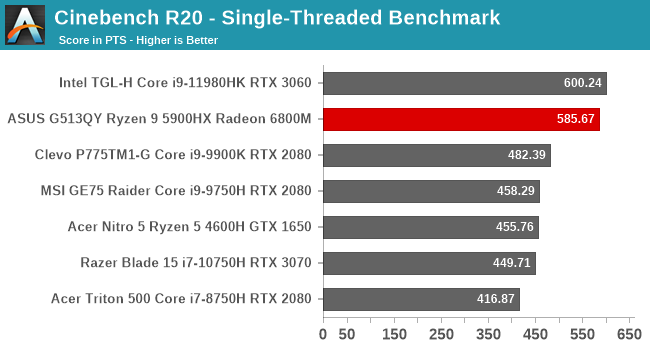
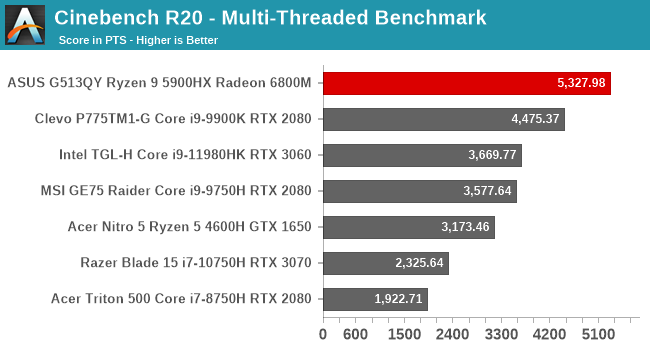
As a purely CPU test, Cinebench allows choosing between a single-thread workload, or multi-threaded, which is useful for many reasons. In terms of single-threaded performance, the Cezanne APU blows past the Skylake-based laptops, and the Zen 2 Ryzen 5 as well, but it is behind by just a hair compared to the latest Tiger Lake processor. But, thanks in part to TSMC’s 7 nm process, and the efficiency of the Zen 3 core, when all sixteen threads are active, the Ryzen 9 spreads its wings and takes off. It is a huge gap, even compared to the Clevo which is outfitted with a desktop-class 95-Watt processor. Part of the AMD advantage is that the system is able to dedicate more power to the CPU when the GPU is not active, and that clearly helps in this scenario.
Handbrake
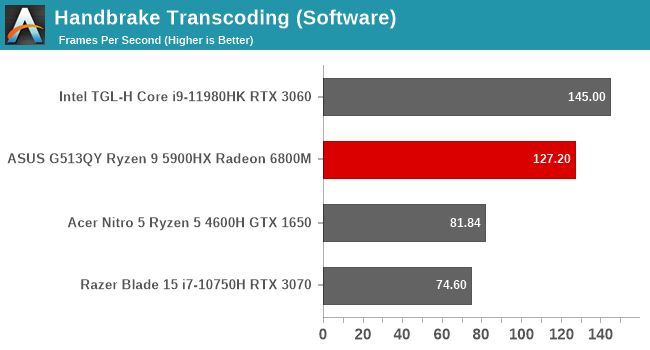
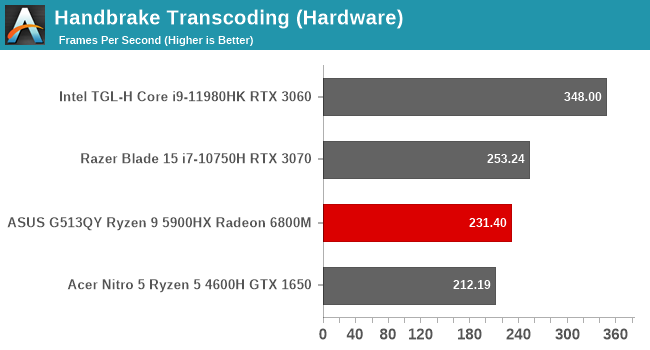
Likely the most popular video transcoding tool around, Handbrake offers the choice to perform the transcode on the processor, or on the fixed-function hardware in the media block. Software encoding will give the best results, even at the same quality settings, but if you just need to transcode something quickly and are not as concerned about the end product, AMD offers VCE, Intel offers QuickSync, and NVIDIA offers NVENC options to accelerate the workload. In terms of software encoding, surprisingly the Tiger Lake H laptop was able to nudge out the ASUS G513QY, and the AMD’s VCE solution is not as quick as NVIDIA’s media block at this test.
7-Zip
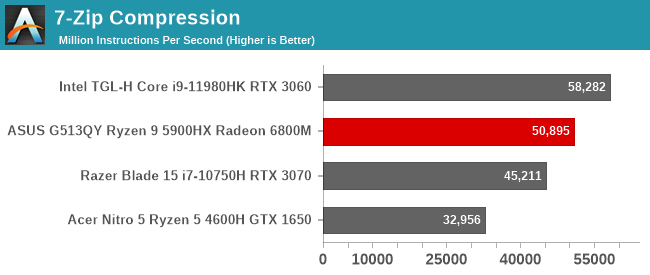
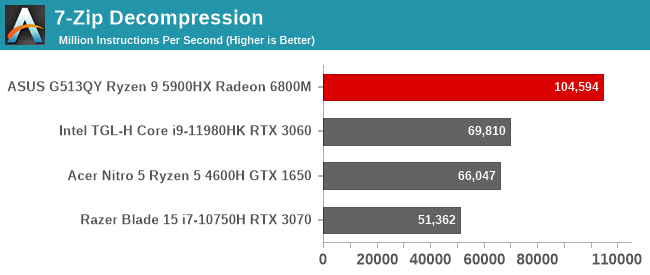
Another common tool is 7-Zip for file compression and decompression, and the utility includes a built-in benchmark which measures both. On the compression side, the Cezanne APU was edged out by the Core i9-11980HK, but on decompression, AMD’s processor is significantly quicker.
Web Tests
Web performance is not just a CPU test, but also a browser test, since web performance is predicated on the underlying browser scripting engine. For all tests, we leverage Microsoft Edge, although any benchmark result is a point in time, since browsers are constantly updated which may impact the results.

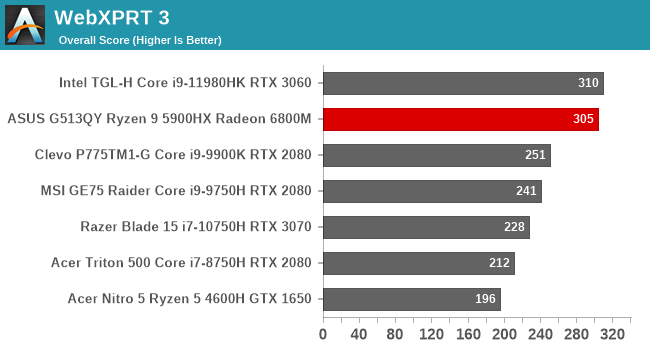
Although Cezanne comes a long way here, it is still slightly behind Tiger Lake in terms of web performance. Much of this comes down to the single-thread performance of the processor, and AMD’s efficiency advantage does not come into play, as the system will not be anywhere near its TDP.
Storage Performance
One of the newer additions to the laptop testing suite is PCMark 10’s storage benchmark, which uses real-world traces in its workloads, simulating overall drive performance much more accurately than a simple bandwidth test. With Cezanne, AMD has stuck with PCIe 3.0, despite offering PCIe 4.0 on their desktop chips, whereas Intel has moved to PCIe 4.0 with Tiger Lake. The review unit of the ASUS Strix G513QY features the Samsung PM991, which is a PCIe 3.0 x4 NVMe drive. The system also has a free M.2 slot, for future expansion.
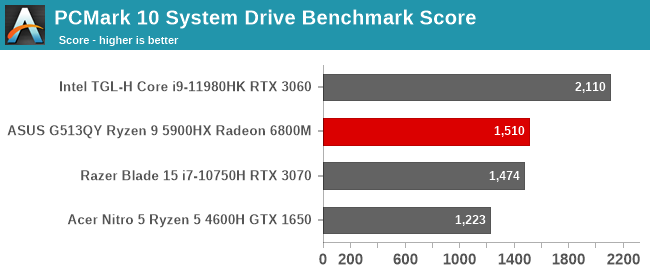

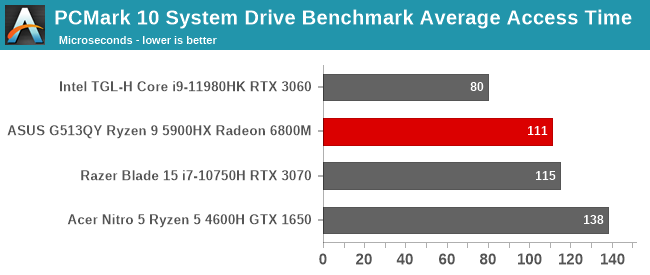
Although the drive can’t compete with the PCIe 4.0 drive in the Intel reference system, the Samsung PM991 does perform well in this benchmark. Compared to the other PCIe 3.0 systems we have tested, this one was at the top.











146 Comments
View All Comments
eva02langley - Tuesday, June 1, 2021 - link
Not interested into anything not 1440p, IPS, 144Hz, top color accuracy and Freesync... AMD promised that on stage yesterday... WTH does Asus smoke...!!!???eva02langley - Tuesday, June 1, 2021 - link
Even you guys admit that ASUS SCREWED up not going 1440p. How awesome... ASUS was already on my blacklist for the disaster the G73JH-A1 was... but this is just ridiculous, they are joke as system implementer. They proved it by their incompetence."AMD targets the Radeon RX 6800M at 2560x1440, and for good reason. As we have seen, in pretty much every title, it is completely CPU bound at 1920x1080, even with the newest Ryzen 9 5900HX as the processor. The synthetic tests, as well as the UHD resolution results, really prove this point.
Although there is certainly a market where the 1920x1080 resolution is desired for the lowest latency, in this system, that panel is really too low of a resolution for such a powerful GPU, and it becomes wasted money spent."
eva02langley - Tuesday, June 1, 2021 - link
Well, i just realized that there is a 1440p panel also... however this 1080p version should not even exist. A 1440p panel resolution can be scaled to 1080p if required... so what is the point? 300Hz??? In optimal gaming scenario at 300Hz constant, you gain 4ms of response.As a comparative, 4ms is the equivalent of ONE FPS.... from 250Hz-251Hz... only idiots will defend this stupidity.
eva02langley - Tuesday, June 1, 2021 - link
Ah, I made a mistake in the calculation. The difference is more in the realm of 50 FPS at a 120Hz basis. So basically, 120Hz to 170Hz is the same amount of time from 144Hz to 300Hz.Makes more sense. But still, 50Hz from 120Hz is worth the same than 144Hz to 300Hz. Meaning those 50Hz are worth those 156Hz. This is because FPS are not a linear factor and a ratio.
Spazosaurus - Tuesday, June 1, 2021 - link
Perhaps the next generation of gpus will have enough power to render even the most demanding titles at 2k60 baseline, at which point I'll happily embrace 2k laptop displays. Native 1080p,to me, looks much better than 1080p on a 2k display. Personally I prefer a lower res native display so that I can crank up the quality settings. Once I'm over 60fps, it does not matter if I'm cpu bound or not. I'm not going to lower a native 2k display to 1080p to get 60fps.Spunjji - Friday, June 4, 2021 - link
This GPU isn't going to have any problems rendering any modern titles in 1440p at more than 60fps - at least, not unless you use RT...DanaGoyette - Tuesday, June 1, 2021 - link
I initially thought: ooh, real home, pageup, pagedown, and end keys... But nope, the right column is media playback control keys, and those text cursor control keys are hidden behind Fn.I guess I'm sticking with my HP Omen.
Pacinamac - Tuesday, June 1, 2021 - link
Competition is the best thing for the consumer. Doubt I'll get an AMD system (I'm a video editor who uses quicksync) but happy to see them doing so well.jenesuispasbavard - Tuesday, June 1, 2021 - link
I'm confused with these GPU tests. Comparisons to the competition at only 1080p? Only this laptop's performance at 4K (no comparisons)? 3DMark Fire Strike - which is *eight* years old now; and no Time Spy or Port Royal? 3DMark total score and not GPU score?ksec - Tuesday, June 1, 2021 - link
Why did they not call it Amdvantage is beyond me.